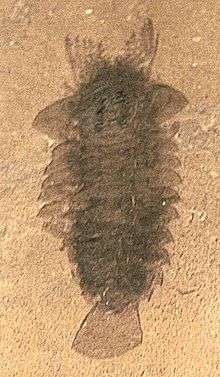Sanctacaris
| Sanctacaris Temporal range: Middle Cambrian | |
|---|---|
 | |
 | |
| Scientific classification | |
| Kingdom: | Animalia |
| Phylum: | Arthropoda |
| (unranked): | stem-group Chelicerata[1] |
| Genus: | Sanctacaris |
| Binomial name | |
| S. uncata | |
Sanctacaris is a Middle Cambrian arthropod from the Burgess Shale of British Columbia. It was most famously regarded as a primitive chelicerate, a group which includes spiders and scorpions, although subsequent phylogenetic studies have not always supported this conclusion; it is best accommodated in the arachnate clade (i.e. as a stem-group chelicerate).[1]
Sanctacaris specimens range from 46 to 93 mm in length.[2] The head bears five pairs of grasping appendages and a sixth pair of large separate appendages. The grasping appendages each bear a short antenna-like second appendage. There are 11 body segments, each with a pair of walking legs and gills. There is a broad, flat paddle-like telson.
Originally Sanctacaris was called informally 'Santa Claws'. Its Latin name translates as "saintly crab".[3] Unlike most other Burgess forms, Sanctacaris is not present in Charles Walcott's 1909 quarry and was discovered at a different level by Desmond Collins in 1980–1981.[3]
References
- 1 2 G. E. Budd, S. Jensen (2000). "A critical reappraisal of the fossil record of the bilaterian phyla.". Biological Reviews of the Cambridge Philosophical Society. 75 (2): 253–95. doi:10.1017/s000632310000548x.
- ↑ Briggs, Derek E. G.; Collins, Desmond (1988). "A Middle Cambrian chelicerate from Mount Stephen, British Columbia" (PDF). Palaeontology. 31 (3): 779–798. Retrieved April 4, 2010.
- 1 2 Briggs, D.E.G.; Erwin, D.H.; Collier, F.J. (1995), Fossils of the Burgess Shale, Washington: Smithsonian Inst Press, ISBN 1-56098-659-X, OCLC 231793738
External links
- "Sanctacaris uncata". Burgess Shale Fossil Gallery. Virtual Museum of Canada. 2011.